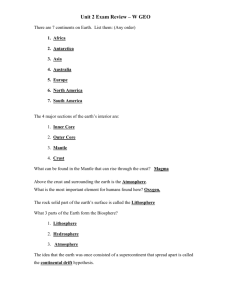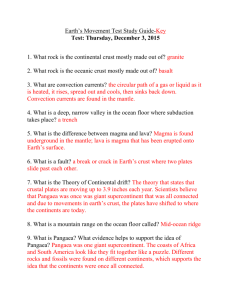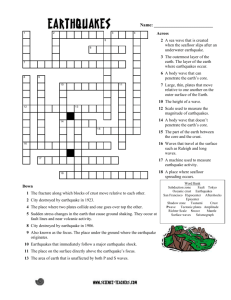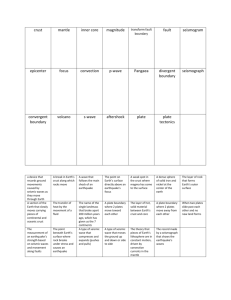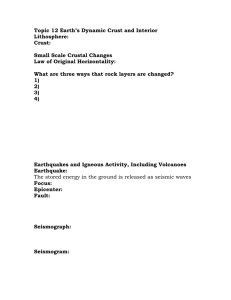Study Guide - Plate Tectonics & Earthquakes
advertisement
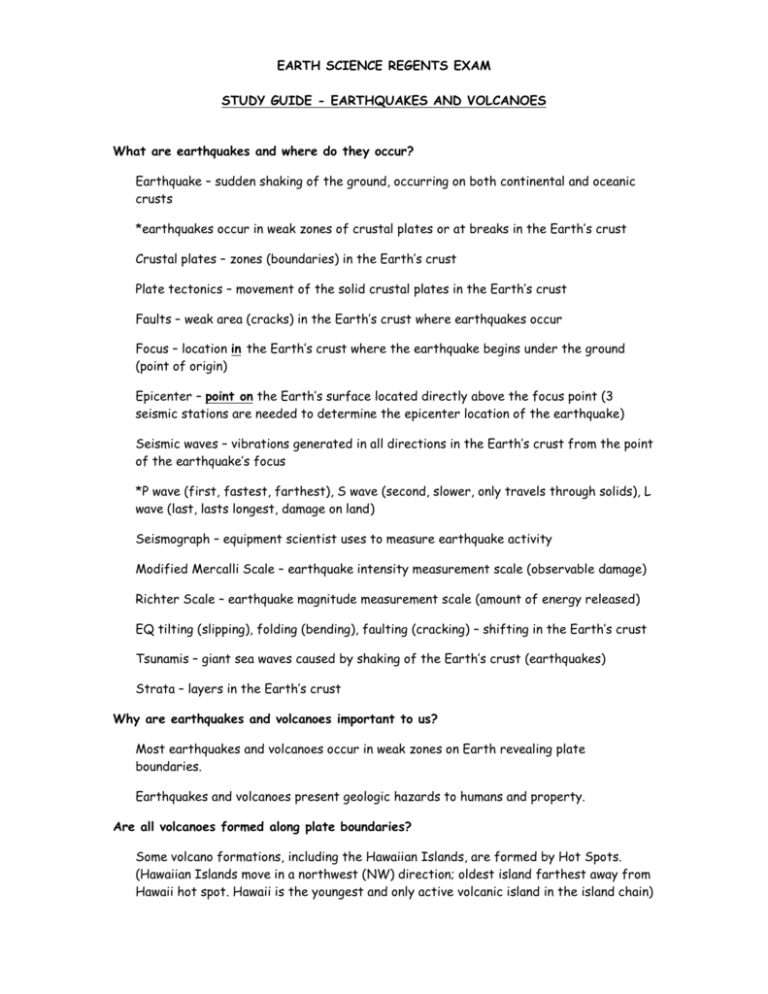
EARTH SCIENCE REGENTS EXAM STUDY GUIDE - EARTHQUAKES AND VOLCANOES What are earthquakes and where do they occur? Earthquake – sudden shaking of the ground, occurring on both continental and oceanic crusts *earthquakes occur in weak zones of crustal plates or at breaks in the Earth’s crust Crustal plates – zones (boundaries) in the Earth’s crust Plate tectonics – movement of the solid crustal plates in the Earth’s crust Faults – weak area (cracks) in the Earth’s crust where earthquakes occur Focus – location in the Earth’s crust where the earthquake begins under the ground (point of origin) Epicenter – point on the Earth’s surface located directly above the focus point (3 seismic stations are needed to determine the epicenter location of the earthquake) Seismic waves – vibrations generated in all directions in the Earth’s crust from the point of the earthquake’s focus *P wave (first, fastest, farthest), S wave (second, slower, only travels through solids), L wave (last, lasts longest, damage on land) Seismograph – equipment scientist uses to measure earthquake activity Modified Mercalli Scale – earthquake intensity measurement scale (observable damage) Richter Scale – earthquake magnitude measurement scale (amount of energy released) EQ tilting (slipping), folding (bending), faulting (cracking) – shifting in the Earth’s crust Tsunamis – giant sea waves caused by shaking of the Earth’s crust (earthquakes) Strata – layers in the Earth’s crust Why are earthquakes and volcanoes important to us? Most earthquakes and volcanoes occur in weak zones on Earth revealing plate boundaries. Earthquakes and volcanoes present geologic hazards to humans and property. Are all volcanoes formed along plate boundaries? Some volcano formations, including the Hawaiian Islands, are formed by Hot Spots. (Hawaiian Islands move in a northwest (NW) direction; oldest island farthest away from Hawaii hot spot. Hawaii is the youngest and only active volcanic island in the island chain) Evidence for crustal movement include: Folded (bent) and faulted (cracked) rock layers Displaced fossils (marine fossils located on top of mountains) Continents fit together like puzzle pieces as fragments of ancient land masses (Pangea) Formation of mountains and volcanoes What causes movement of lithospheric plates (Earth’s crust)? Convection currents continuously move plates (hot crustal plates rise, cool, then sink) Ocean floors generally younger than the continents Magnetic alignment of igneous rocks near ocean ridges (divergent seafloor spreading) *THINGS TO REMEMBER: 1. Subsidence – the sinking of the crust. (subduction zone—trench—underwater valley/canyon) 2. Uplift – the lifting of the crust (forms mountains on the continental crust) 3. Earth’s plates move due to convection currents in the upper-mantle (asthenosphere): warm magma rises, cools then sinks moving crustal plates up and down so they collide, separate, or snag each other. 4. At mid-ocean ridges (underwater mountain) new oceanic crust is created (spreading seafloor center as magma rises up between plates). Age of the rock increases as distance from ridge increases (ridge center is newest rock material). Divergent Plate Boundary 5. Ocean trenches (subduction zone) form when continental crust and oceanic crust converge/collide, and old crust is destroyed. Subduction Plate Boundary 6. Mountains are constructed when continental plates collide. Convergent Plate Boundary 7. No land is constructed or destructed when plates slide past each other (i.e. San Andreas Fault, California). Transform Plate Boundary 8. P-waves (compression waves) travel faster and farther than S-waves. 9. P-waves travel through solids, liquids, and gases. 10. S-waves (shear waves) travel through solids only (NOT through the outer core). 11. 12. No waves travel through the Shadow Zone (102 o – 143o) of the Earth. Need a minimum of three (3) seismograph stations to determine the location of an epicenter. Where their distances from the epicenter intersect determines the exact location of the earthquake’s epicenter. 13. Focus: underground point of origin of the earthquake. Epicenter: point located directly aboveground of the earthquake (where the earthquake is felt and observed/damage occurs) 14. Modified Mercalli Scale (I—XII) based on observations felt/seen. Richter Scale (1-10) based on magnitude (amount of energy released compared to TNT). 15. Fault: break/crack in Earth’s crust as a result of an earthquake. Tilt: diagonal slipping of Earth strata. (indicated on a diagram with a diagonal line) 16. Hot spots: permanent hole in the Earth’s crust releasing magma to the Earth’s surface 17. Tsunamis: gigantic sea wave caused by an earthquake 18. Earthquakes and volcanoes occur together around the Pacific Rim (Ring of Fire) where plate boundaries meet.

